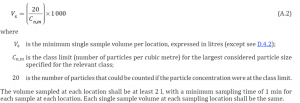The following frequently asked questions arose at a presentation given by PMS Senior GMP Scientist, Mark Hallworth, on the 6th of December on the topic of EU GMP Annex 1 Environmental Monitoring.
Is there an international standard or guideline for sampling 1m³ total particle counts and viable particles with air samplers like the MiniCapt® mobile device for routine monitoring of production areas with classifications A, B, C, and D?
No, there is no specific guidance that mandates sampling 1m³ of air for routine environmental monitoring. ISO14644-1 provides a minimum sample volume formula for cleanroom classification, emphasizing the need for a representative sample, as shown below.

Can I sample an air volume of less than 1m³ without routine monitoring within existing regulations?
Yes, the regulations do not specify a fixed volume. For routine monitoring, especially in Grade A/B areas, the focus is on the frequency of measurement rather than the individual sample volume.

Can I adopt the same sampling volume values used for HVAC performance quality in routine total particle counting?
While there’s no fixed volume requirement, ISO14644-1 suggests a minimum sample volume for cleanroom classification. For routine monitoring, it’s more about the relationship between samples and the frequency of measurement.
How does Annex 1 address the misinterpretation of cubic meter monitoring from 2003?
Annex 1 addresses the 2003 misinterpretation by adding paragraph 9.21. If an alternative to instrument flow rate is used, justification is required.
EU GMP Annex 1: 2023, 9.21: The size of monitoring samples taken using automated systems will usually be a function of the sampling rate of the system used. It is not necessary for the sample volume to be the same as that used for formal classification of cleanrooms and clean air equipment. Monitoring sample volumes should be justified.
What approach does Annex 1 recommend for microbial monitoring?
Similar to total particle counting, microbial monitoring focuses on frequency and duration. In lower-risk areas with higher microbial concentrations, a shorter sample period may be used. Continuous monitoring is now required for low concentrations of microbial activity.
What is the recommended sampling frequency in Annex 1 for Grade A/B and Grade C/D areas?
For Grade A/B areas with continuous monitoring, the relationship between samples defines action and alert responses. In Grade C/D areas, where risk is lower, a reduced sampling frequency is acceptable, typically with the same sample volume.
Can an alternative to instrument flow rate be used for air sampling, and how is it justified?
Yes, an alternative can be used, but justification is necessary. Annex 1 addresses this concern and emphasizes the importance of justification when deviating from the instrument.
What considerations are given for microbial monitoring concentrations and durations?
EU GMP Annex 1: 2023, 9.30 provides a table of maximum concentrations for monitoring, with notes supporting suitable monitoring frequencies and durations based on the level of microbial activity and risk.
Can the particle alert limit be defined point by point within the same room or must it be defined considering the room as a criterion for the alert limit?
Ideally, each sample point should be assessed for the characteristics that reflect the conditions at that point. Each sample location for monitoring has been selected as it represents an individual Critical Control Point within the process, and so it should also have tolerances that reflect the risk assigned. In Grade B, C, or D environments, common values for particle burden are often influenced by general activities occurring in the background of the room, rather than specific tasks performed at a particular point. It’s important to note that the activities in one Grade B room can significantly differ from those in an adjacent room. Despite these differences, the overall particle burden in both rooms might result in similar values.
EU GMP Annex 1: 2023, 9.9: Appropriate alert levels and action limits should be set for the results of viable and total particle
monitoring. The maximum total particle action limits are described in Table 5 and the maximum
viable particle action limits are described in Table 6. However, more stringent action limits may be
applied based on data trending, the nature of the process or as determined within the CCS. Both viable
and total particle alert levels should be established based on results of cleanroom qualification tests
and periodically reviewed based on ongoing trend data.9.10 Alert levels for grade A (total particle only) grade B, grade C and grade D should be set such that
adverse trends (e.g. a numbers of events or individual events that indicate a deterioration of
environmental control) are detected and addressed.
Can I establish different limits for areas of the same level/grade, as long as they do not exceed the limits established in Annex 1? Can I exceed the limits established in the guide depending on my area/process/history and based on a risk assessment?
The biggest difference between a limit (normative) and a level (process defined) is the degree of investigation required following an excursion. If a failure would yield a potentially catastrophic failure of the environment and cause potential and significant risk to the product, then it’s a LIMIT and requires a full investigation. If it is an excursion that has a known root cause and a function of process variables – then it is a LEVEL. Use this definition of limits and levels to guide your application to Annex 1.
*These FAQs are intended to provide insights into EU GMP Annex 1. Always refer to the specific standards and guidelines for your industry and location.
Do you have a question that wasn’t answered?

